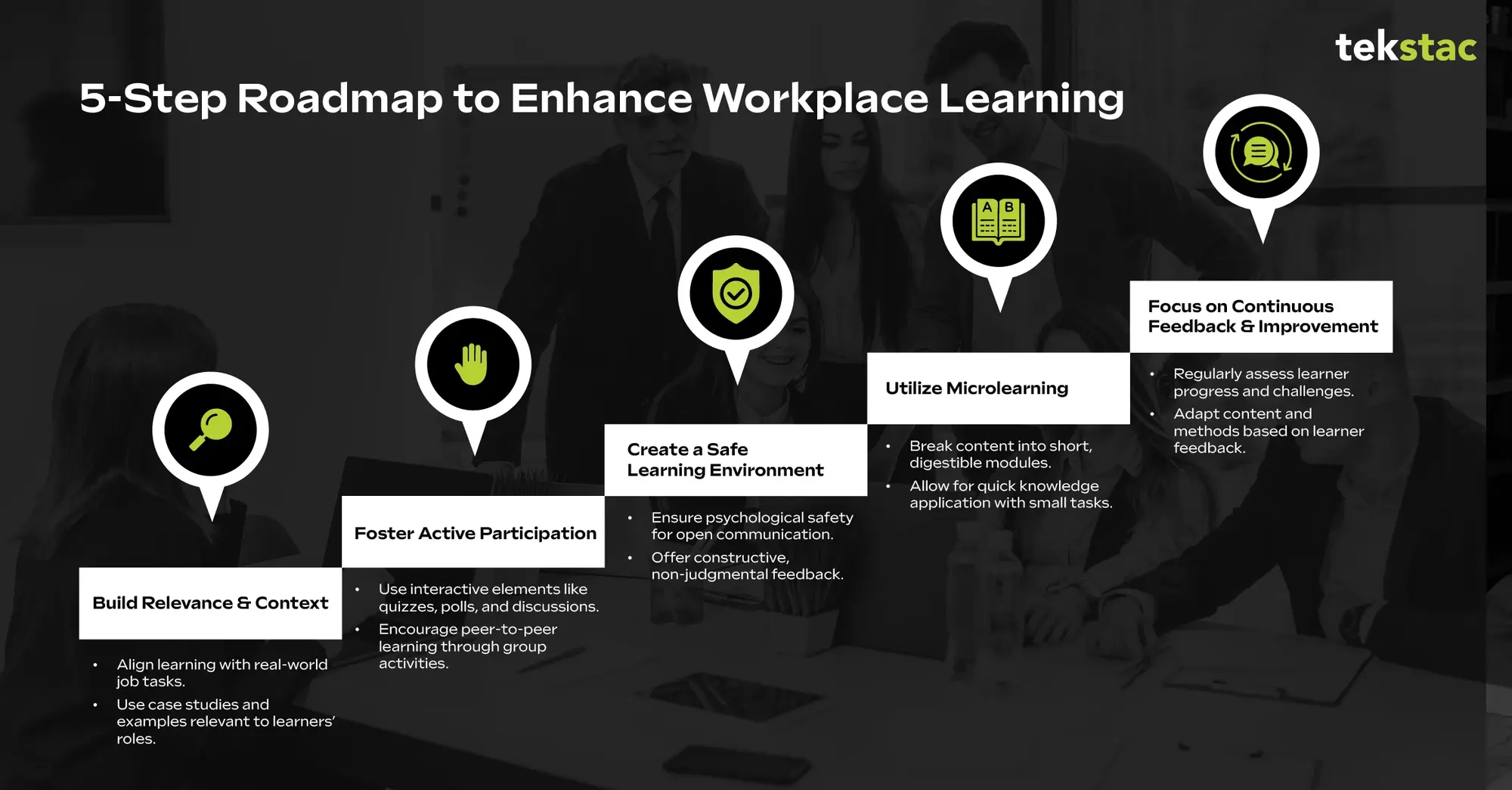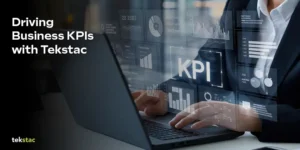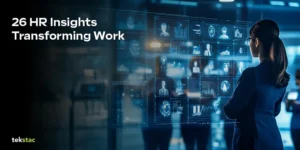Workplace Learning Strategies: 5 Proven Tactics to Boost L&D Engagement
December 24, 2024

Why Traditional Training Is No Longer Enough for Workplace Learning
Traditional classroom training is fading fast. To stay competitive, companies must rethink how their teams learn and grow. Business leaders across industries report significant skill gaps in their workforce, making the evolution of learning programs a critical priority. The key challenge lies in creating engaging learning environments that effectively bridge the gap between theoretical knowledge and practical business applications.
Let’s explore five proven workplace learning strategies that empower learning and development (L&D) leaders to transform routine training into engaging, performance-driven workplace learning experiences.
- Create Immersive Practice Environments
- Put AI-Powered Personalization into Practice
- Integrate Learning into Daily Workflows
- Use Progress Tracking Driven by Data
- Encourage Collaborative Learning Environment

1. Create Immersive Practice Environments
The disconnect between theory and practice frequently causes poor skill memory. Companies that implement experiential learning programs enjoy a 55% higher rate of skill acquisition than those that use standard training techniques, says the Josh Bersin Company’s Corporate Learning Report 2024.
Look at these implementation techniques:
- Create sandbox settings where staff members can safely practice new abilities.
- Make scenario-based tasks that replicate actual work environments.
- Include tools for instant feedback to promote learning.
Professionals may practice everything from cloud infrastructure to programming languages in real-time with Tekstac’s integrated lab environment, for instance, guaranteeing that abilities translate seamlessly to real-world work situations.
2. Put AI-Powered Personalization into Practice
One-size-fits-all training plans are becoming obsolete. Learning in the modern workplace requires large-scale customization. IDC’s recent research shows that companies that use AI-driven learning systems see a 30% reduction in training time and a 45% increase in employee participation in development programs.
Among the components of effective personalization are:
- Utilizing computerized evaluations to analyze individual skills gap
- Developing personalized learning programs according to job specifications and professional objectives
- Changing the level of difficulty of the content according to student performance and progress
Making learning feel more like a customized path to mastery rather than a required task is crucial.
3. Integrate Learning into Daily Workflows
When workplace learning is smoothly incorporated into routine responsibilities, it is most successful. For example, a sales representative might access quick microlearning modules about new product features while updating their CRM entries, or a software developer could review code optimization techniques through integrated IDE plugins while writing code.
This method, which is frequently referred to as “learning in the flow of work,” enables staff members to apply newly acquired knowledge to actual problems right away.
Among the implementation techniques are:
- Dividing intricate subjects into modules for microlearning
- Supplying timely learning materials that are integrated into job tools
- Developing searchable knowledge bases and rapid reference guides
Organizations can improve engagement and knowledge retention by providing easy access to learning materials in real-world work scenarios.
4. Use Progress Tracking Driven by Data
Modern L&D leaders require quantitative and qualitative data to measure learning effectiveness. While data analytics dashboards track measurable outcomes like completion rates, skill assessments, and performance improvements, qualitative feedback through surveys and team leader observations helps evaluate behavioral changes and practical application of new skills
Dashboards for advanced analytics make it easier to monitor program impact as well as individual progress. Businesses that successfully use learning analytics report a 41% boost in employee productivity and a 53% increase in employee retention, according to research from Brandon Hall Group’s Learning Strategy Study.
Key metrics to track include:
- Time to competency for new skills
- Utilizing acquired abilities in practical projects
- effect on both individual and team performance
- Return on Learning Investment (ROLI)
Organizations may track these KPIs in real time with Tekstac’s extensive analytics dashboard, which aids L&D leaders in making data-driven choices regarding their educational initiatives.
5. Encourage Collaborative Learning Environment
Creating chances for peer learning and information sharing can greatly increase engagement, even though individual learning routes are still vital. According to the Enterprise Learning Annual Report 2024 by Fosway Group, 94% of L&D leaders now place a high priority on collaborative learning strategies, with peer-to-peer learning having the greatest influence on skill development.
Among the strategies for collaborative learning that work well are:
- Establishing mentor marketplaces to facilitate the exchange of expertise
- Setting up team-based learning challenges and hackathons
- Leading peer-to-peer educational activities
- Creating practice communities centered on particular skill sets
Transitioning: Execution Advice for Successful Workplace Education
It takes considerable preparation and execution to turn traditional training into engaging workplace learning. Employee expectations and corporate goals must be met by contemporary workplace learning solutions.
How do you implement learning in the workplace?
- Examine ongoing programs: Look for ways to add additional practical experience and real-world applicability to current training programs. To prioritize changes, find the gaps between industry best practices and present workplace learning processes.
- Begin Small: Before expanding the program throughout the entire company, start with a pilot project in a single team or department. This strategy enables you to improve workplace learning tools and techniques in response to immediate input and outcomes.
- Assess and Modify: Utilize learning analytics to monitor efficacy and engagement, then make modifications in light of data-driven insights. Pay attention to measures that show a clear link between workplace learning programs and company results.
- Get Input: Gather feedback from learners on a regular basis regarding their preferences and experiences to improve the teaching methodology. This ongoing feedback loop aids in maximizing the effectiveness of workplace learning tactics.
How to Overcome the Top Workplace Learning Challenges
Organizations frequently run across a number of challenges while implementing new learning methodologies.
Here’s how to deal with typical workplace learning obstacles:
1. Time Limitations
You can handle time constraints with the use of contemporary workplace learning technology by:
- Providing microlearning courses that accommodate hectic schedules
- Making mobile learning accessible for access while on the go
- Including learning materials in workflow tools at the right moment
2. Barriers to Engagement
Boost L&D involvement by:
- Features of gamification that increase interaction in learning
- Features of social learning that promote peer cooperation
- Recognition programs that honor academic success
3. Application of Skills
- Close the knowledge gap between application and learning by:
- Developing practice scenarios inspired by actual work environments
- Putting project-based learning opportunities into practice
- Putting mentorship programs in place to transmit knowledge
What the Future of Workplace Learning Looks Like
Workplace learning is the integration of continuous, personalized, and collaborative training directly into daily workflows. It enables employees to build skills faster, apply them immediately, and drive measurable business performance.
The capacity to provide effective, engaging learning experiences is becoming increasingly important as firms continue to navigate the rapid changes in technology. According to McKinsey’s latest State of Organizations Report, 87% of executives report existing or expected skills gap in their workforce, indicating that transforming learning programs is a top priority.
The age of static, one-size-fits-all training is over. Next-gen corporate learning is agile, personalized, and immersive.
Effective workplace learning programs will prioritize the following:
- Flexible learning programs that change to meet the needs of employees
- Incorporating cutting-edge technologies such as VR and AR
- Improved analytics to gauge the impact of learning
- Greater congruence between educational initiatives and corporate strategies
Beyond merely imparting knowledge, workplace learning aims to provide life-changing experiences that enable staff members to develop their abilities in the context of their regular jobs.
This strategy promotes corporate performance and personal growth by:
- Quickening the acquisition and mastery of skills
- Increasing employee retention by providing opportunities for advancement
- Increasing the resilience and adaptability of the workforce
- Encouragement of innovation and competitive advantage
Ready to Transform Your Learning Culture?
Effective workplace learning methods must be a top priority for firms if they want to remain competitive in today’s quickly changing business landscape. L&D leaders can establish learning environments that produce quantifiable business results by implementing the five strategies mentioned above and utilizing cutting-edge learning platforms like Tekstac.
Want to future-proof your workforce? Book a strategy session with Tekstac today and see how our workplace learning platform delivers results.
FAQs on Workplace Learning Strategy
1. What is the future of workplace learning?
The future is agile, immersive, and personalized, leveraging technologies like AI, VR, and AR, and aligning learning initiatives more closely with business strategy to foster innovation and adaptability.
2. How can companies get started with transforming workplace learning?
Start with pilot programs, gather feedback, track engagement and outcomes with analytics, and iteratively refine learning strategies to align with both employee and business needs.
3. What is the 80/20 rule for learning?
The 80/20 rule for learning means that 80% of results come from 20% of focused effort. In workplace learning, it highlights prioritizing the most valuable skills and training activities that drive the biggest performance impact.
4. How does workplace learning impact employee engagement?
Engaging workplace learning links skill development directly to daily tasks, making employees feel more competent, confident, and connected to business outcomes.





